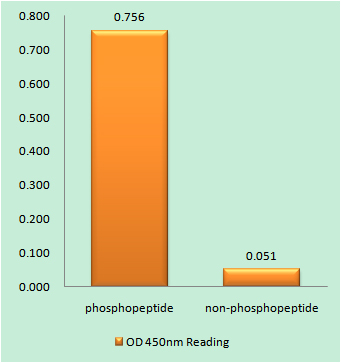p107 (phospho Thr369) Polyclonal Antibody
- Catalog No.:YP0980
- Applications:WB;IHC;IF;ELISA
- Reactivity:Human;Mouse
- Target:
- p107
- Fields:
- >>Cell cycle;>>Cellular senescence;>>TGF-beta signaling pathway;>>Human papillomavirus infection;>>Viral carcinogenesis
- Gene Name:
- RBL1
- Protein Name:
- Retinoblastoma-like protein 1
- Human Gene Id:
- 5933
- Human Swiss Prot No:
- P28749
- Mouse Gene Id:
- 19650
- Mouse Swiss Prot No:
- Q64701
- Immunogen:
- The antiserum was produced against synthesized peptide derived from human RBL1 around the phosphorylation site of Thr369. AA range:335-384
- Specificity:
- Phospho-p107 (T369) Polyclonal Antibody detects endogenous levels of p107 protein only when phosphorylated at T369.
- Formulation:
- Liquid in PBS containing 50% glycerol, 0.5% BSA and 0.02% sodium azide.
- Source:
- Polyclonal, Rabbit,IgG
- Dilution:
- WB 1:500-2000 IHC 1:100 - 1:300. ELISA: 1:5000. IF 1:50-200
- Purification:
- The antibody was affinity-purified from rabbit antiserum by affinity-chromatography using epitope-specific immunogen.
- Concentration:
- 1 mg/ml
- Storage Stability:
- -15°C to -25°C/1 year(Do not lower than -25°C)
- Other Name:
- RBL1;Retinoblastoma-like protein 1;107 kDa retinoblastoma-associated protein;p107;pRb1
- Molecular Weight(Da):
- 121kD
- Background:
- The protein encoded by this gene is similar in sequence and possibly function to the product of the retinoblastoma 1 (RB1) gene. The RB1 gene product is a tumor suppressor protein that appears to be involved in cell cycle regulation, as it is phosphorylated in the S to M phase transition and is dephosphorylated in the G1 phase of the cell cycle. Both the RB1 protein and the product of this gene can form a complex with adenovirus E1A protein and SV40 large T-antigen, with the SV40 large T-antigen binding only to the unphosphorylated form of each protein. In addition, both proteins can inhibit the transcription of cell cycle genes containing E2F binding sites in their promoters. Due to the sequence and biochemical similarities with the RB1 protein, it is thought that the protein encoded by this gene may also be a tumor suppressor. Two transcript variants encoding different isoforms hav
- Function:
- function:Key regulator of entry into cell division. Directly involved in heterochromatin formation by maintaining overall chromatin structure and, in particular, that of constitutive heterochromatin by stabilizing histone methylation. Recruits and targets histone methyltransferases SUV420H1 and SUV420H2, leading to epigenetic transcriptional repression. Controls histone H4 'Lys-20' trimethylation. Probably acts as a transcription repressor by recruiting chromatin-modifying enzymes to promoters. Potent inhibitor of E2F-mediated trans-activation. Forms a complex with adenovirus E1A and with SV40 large T antigen. May bind and modulate functionally certain cellular proteins with which T and E1A compete for pocket binding. May act as a tumor suppressor.,PTM:Exists in both phosphorylated and unphosphorylated forms, and T, but not E1A, binds only to the unphosphorylated form. Cell-cycle arrest
- Subcellular Location:
- Nucleus .
- Expression:
- Testis,
- June 19-2018
- WESTERN IMMUNOBLOTTING PROTOCOL
- June 19-2018
- IMMUNOHISTOCHEMISTRY-PARAFFIN PROTOCOL
- June 19-2018
- IMMUNOFLUORESCENCE PROTOCOL
- September 08-2020
- FLOW-CYTOMEYRT-PROTOCOL
- May 20-2022
- Cell-Based ELISA│解您多样本WB检测之困扰
- July 13-2018
- CELL-BASED-ELISA-PROTOCOL-FOR-ACETYL-PROTEIN
- July 13-2018
- CELL-BASED-ELISA-PROTOCOL-FOR-PHOSPHO-PROTEIN
- July 13-2018
- Antibody-FAQs
- Products Images

- Enzyme-Linked Immunosorbent Assay (Phospho-ELISA) for Immunogen Phosphopeptide (Phospho-left) and Non-Phosphopeptide (Phospho-right), using RBL1 (Phospho-Thr369) Antibody

- Immunohistochemistry analysis of paraffin-embedded human lymph node, using RBL1 (Phospho-Thr369) Antibody. The picture on the right is blocked with the phospho peptide.



